We’ve all got them. Those friends who, come summer, can always be found in their swimsuits by the sea, soaking up the sun’s rays or, more likely, swimming in the ocean waves.
So, the next time you’re looking for a gift for the water lovers in your life, consider giving a snorkeling or scuba diving gift voucher. There are endless underwater adventures to be had, whether you prefer to glide across the water’s surface and snorkel or breathe underwater with a scuba diving experience.
The beauty of experiences is that they are not disposable. You can continue to participate in the experience after you finish it, or you may never do it again, but the memories you make will stay with you for the rest of your life. Ask any diver and they’ll tell you exactly what their first breath underwater felt like.
We offer a vast array of snorkeling and diving gift experiences that will be sure to leave a lasting memory for whoever you choose to gift it to.

For those who prefer calmer waters or are a little nervous about what lies beneath the surface, a snorkeling gift is the ideal way to get a taste of life under the sea. Snorkeling is suitable for beginners and takes place in clear, shallow water, allowing for free exploration of the ocean floor as snorkelers float on the surface of the water. After putting on the gear provided they will be ready to explore the ocean floor!
Snorkeling is a great way to explore the stunning coral reefs found in the world’s tropical oceans. Snorkelers will be in for a treat as they swim among beautiful tropical marine life surrounded by colorful coral and pristine turquoise water. They will have the chance to see lots of colourful reef fish, Turtles and even a possible sighting of Black Tip reef sharks! But don’t worry they are super chilled and just swim past you not even noticing you are there.
A snorkeling experience is the ideal way to introduce your ocean-loving friends and family to the underwater world from the surface of the water.

A scuba diving gift is ideal for those who are a little more daring and want to breathe underwater. A diving gift will allow your recipient to truly explore the depths of the deep blue, making them feel like one of the marine life! Even better, we have a wide selection of diving gifts, allowing anyone, regardless of experience level, to explore the ocean.
We provide an introductory diving experience (Discover Scuba Diving) that is ideal for beginners and is sure to instill a lifelong love of adventure in the sea! For those who want to take their diving hobby to the next level, consider gifting a certified diver course, of which we have many to offer! And once certified, the number of underwater adventures to be had are vast, with endless options to choose from. No matter which gift you choose, your recipient will return to shore with an unforgettable memory.

If you don’t have the funds to give an entire course to your friend or loved one you still have a couple of options! Consider going in on a joint gift with a few other friends or family members and split the cost. Don’t have anyone interested in going in on the gift with you? How about gifting a money voucher towards the diving experience.
So, no matter how you do it, give the gift that will continue to give for years to come. Give the gift of scuba diving and change someone’s life!
“Happiness doesn’t come from the things you own, it comes from things you do and the people who share your adventures”
PADI
Kota Kinabalu is a perfect dive location for those who love macro! The diving here is very easy & you won’t need to go too deep to search different species of macro. Have you ever wondered what macro critters we have here? We have listed down 5 fascinating macro critters you can find diving off Kota Kinabalu.
Frogfish can be found when diving at the Tunku Abdul Rahman Park. They are considered one of the strangest looking fish in the water, however, they are also a master in hiding underwater. They camouflage themselves very well & are very good at adapting to their surroundings. They are able to hide from predators using their amazing disguise ability. Frogfish come in different shapes, colours & skin textures according to the surrounding environments that they live in. Some even resemble the coral or rock so very much that you won’t be able to tell the difference! Their amazing chameleon-like camouflage ability is useful when it comes to hunting. The potential prey like small fish will just swim past them without noticing the well-hidden frogfish until it’s too late.
As for divers, you will need to have a pair of eagle eyes to spot them! Having a dive guide who is familiar with the surrounding sea condition will come in handy in this situation. It is definitely a treat to be able to see frogfish underwater. The colour of frogfish can be varied throughout their lifecycle. Frogfish have contrasting colour, together with their weird-looking face, it makes them one of the popular photography subject for divers.
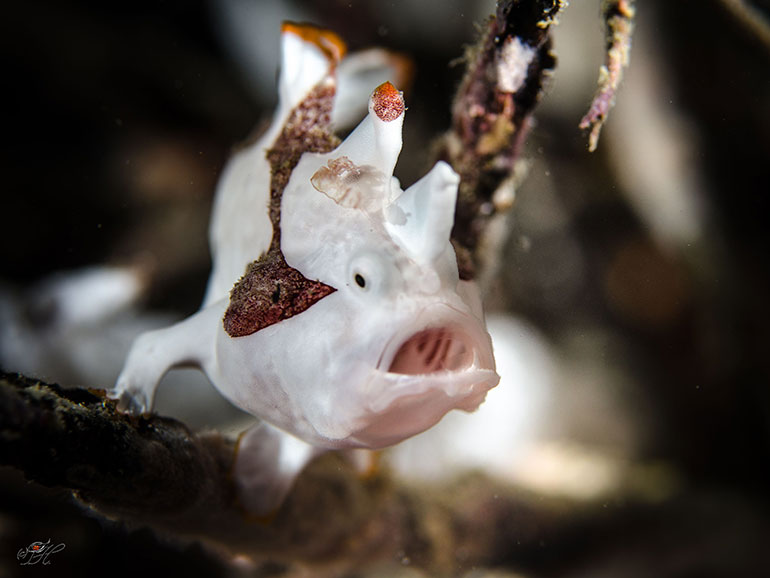
Blue-ringed octopus are small in size, however, they are definitely not as harmless as they look! This tiny creature can even fit into the palm of a human hand, but the venom that they carry is enough to kill a human and until now, there is no antidote for it. It is considered one of the most dangerous animals in the ocean. The blue-ringed octopus gets its name from the bright blue rings that appear when they are threatened.
Although the blue-ringed octopus is venomous, there have been very few reports of divers being bitten by them. They are usually hidden away in the morning and awake at night. It is perfectly safe to dive with them as long as you don’t go and provoke them. We often find them hidden among coral reefs, small stones & sandy bottoms.
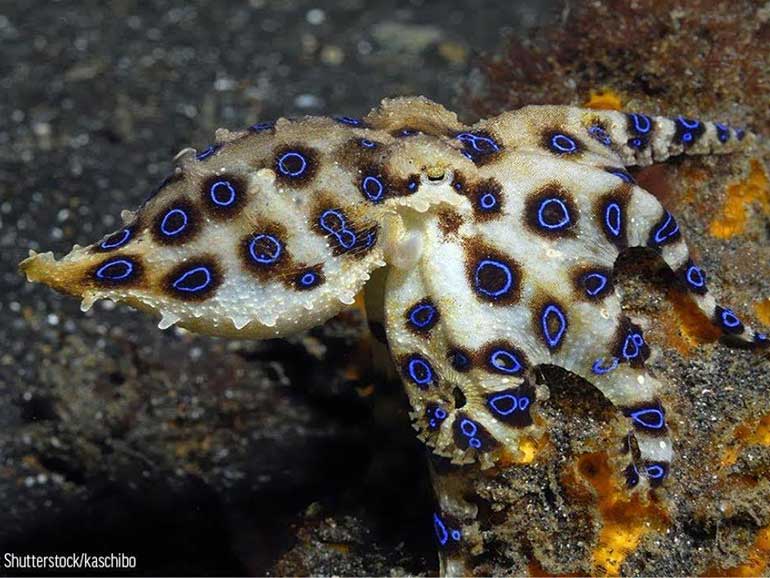
The islands around Kota Kinabalu city are definitely some of the best spots for those who are nudibranch lovers! We can find many different types of nudibranch when diving around here.
Nudibranchs are one of the most sought-after subjects for underwater photography. This is because nudibranchs have very vibrant colours and come in different unique shapes. They move very slowly through the water however you often see them stationary, so divers have more time to photograph their beautiful side from the best angle. There are even some divers who head out to dive especially to find nudibranchs so that they can take pictures of them, and add into their collection!
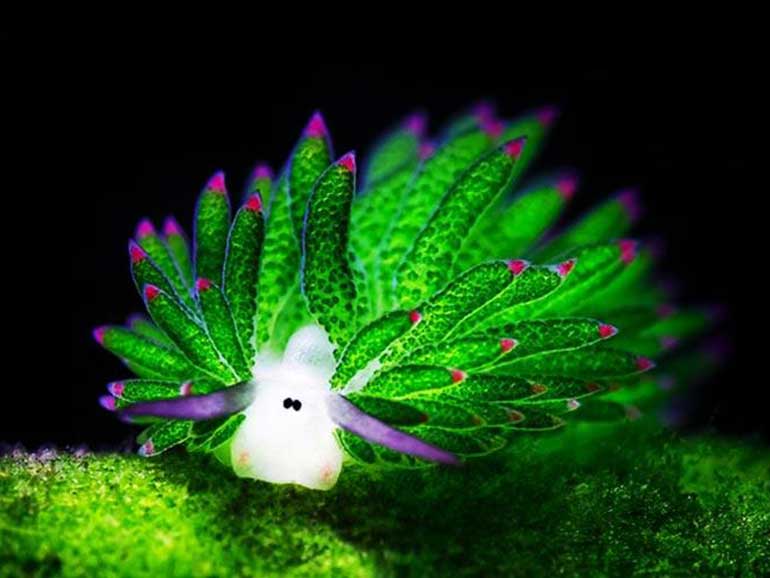
When it comes to what creature is the hardest to spot, the seahorse is surely on the list! The types of seahorse that we find here are generally very tiny. Spotting a seahorse is like playing a searching game underwater. Seahorses live in shallow areas and often in seagrass beds.
Seahorses have a very unique appearance, they have a horselike head, prehensile tail, independently moving eyes, and brood pouch. As they are not very good swimmers, divers are still able to get that perfect shot of them even when they are super small.
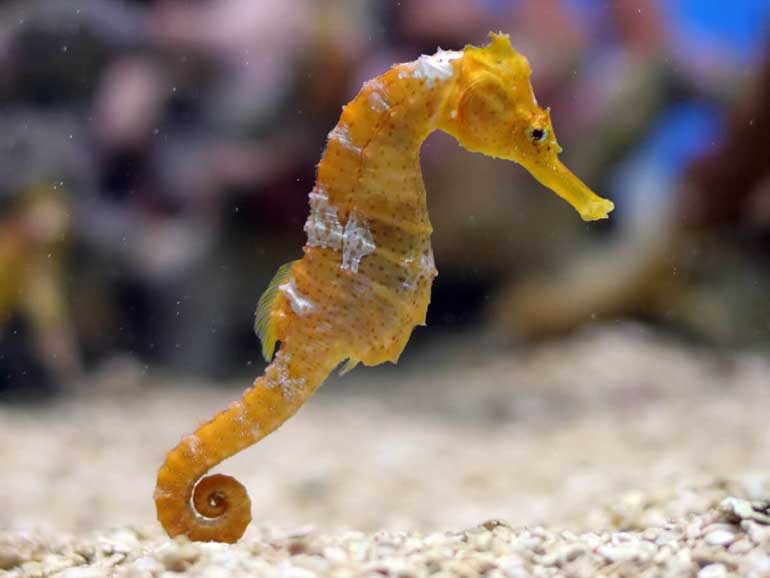
The cuttlefish is another macro critter that you can see when diving at Kota Kinabalu. Cuttlefish will release a cloud of ink when they feel threatened, which gives them some time to escape. Besides, cuttlefish is another king of camouflage. They often bury themselves into the sandy bottom, leaving only their eyes exposed. Other than that, cuttlefish can change colour too according to their surroundings, which makes it harder for us to find it! You can easily miss them if you are not being cautious. But no worries, our expert dive guides will show you exactly where to find them when you are diving with us.
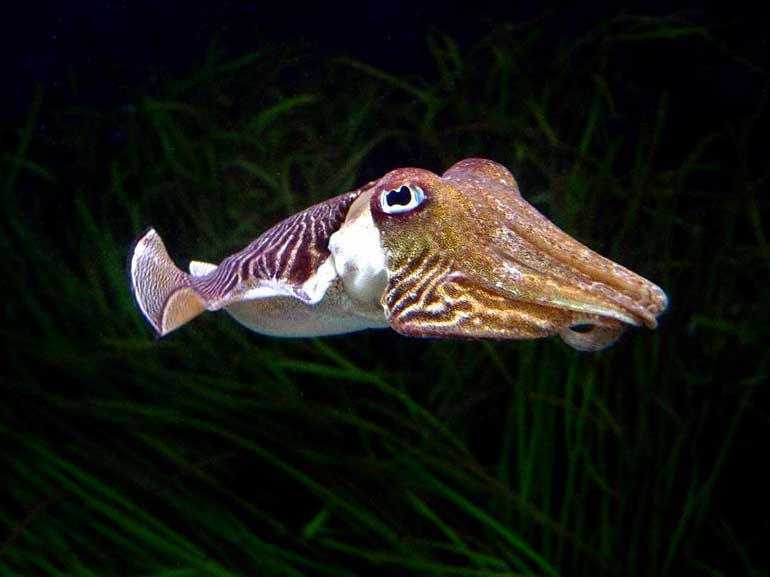
Do you want to explore the macro diving around Kota Kinabalu? Contact us today!
Snorkeling, what better way to see the spectacular underwater marine life if you are not yet ready to step into the world of diving. Gliding through the water with your fins, mask & snorkel viewing the beautiful corals & other marine life.
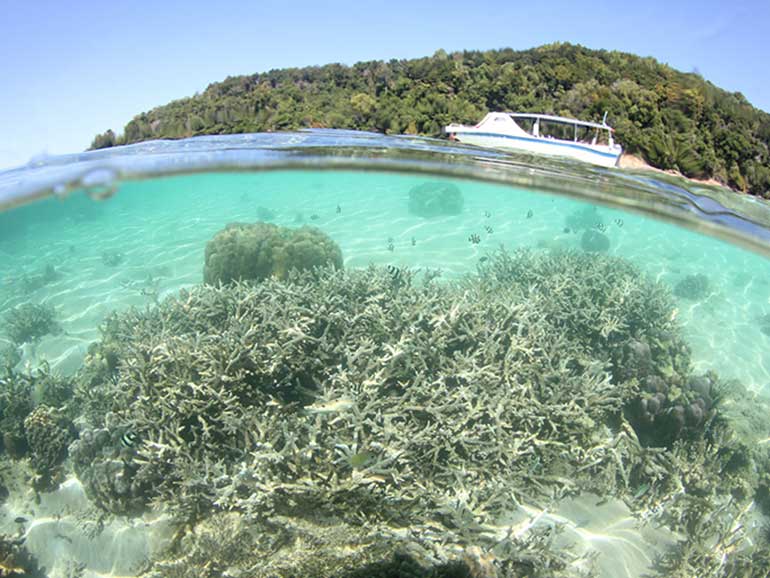
First off, let’s get down to the basics. What is snorkeling? The dictionary defines snorkeling as the practice of swimming on or underwater water while equipped with a diving mask, a shaped breathing tube called a snorkel, and fins.
The snorkeling equipment allows you to swim while breathing with your face and body submerged underwater. Unlike scuba diving though, you are confined to staying on the surface (unless you are taught to skin dive – but we will talk about this in a different blog) as you don’t want your snorkel to fill up with water.
A snorkeling trip with Scuba Junkie KK starts early in the morning at Jesselton point where you meet our friendly team. The destination is decided on the morning of your activity but it will be a few sites within the Tunku Abdul Rahman Marine park. Your day is designed to give you plenty of time in the water exploring three different spots around TARP as well as some time to relax on the flawless white sandy beaches & enjoy the ocean view.
The boat ride will take around 15-20 minutes. Upon reaching the island, everything is prepared for you & all you have to do is jump into the crystal blue ocean!
Depending on numbers, our snorkelers will either join our dive boats or have their own dedicated snorkeling boat, either way our staff will be on hand to help you with safety advice, tips on the best places to snorkel as well as helping you identify a variety of marine life.
Two morning trips which are around 45 minutes to 1 hour are followed by a relaxing lunch on one of the Islands, while enjoying the tropical paradise. The third and final trip of the day takes place after everyone has had enough time to digest lunch, usually around 2pm. After the third trip our speedboats safely shuttle you back to Kota Kinabalu, while you enjoy the views of the Islands and Mt. Kinabalu while discussing the marvels that you have just seen with buddies and our team.
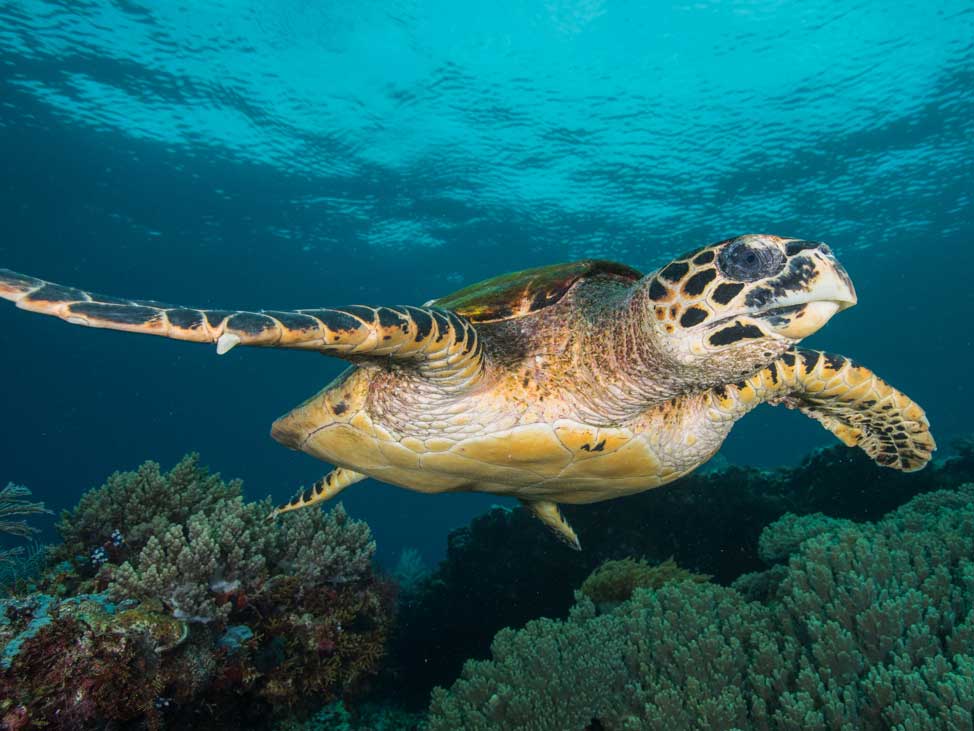
We have a great variety of sites which are amazing for snorkeling, popular ones being Eel Garden, Gaya & The Rock, Mamutik which are known for seeing Black tip Reef Sharks in the shallows, don’t worry though they are super chilled and just swim pass not even noticing you are there! Fish Feeding & Coral Garden around Sapi Island along with South Sulug are great sites known for seeing schools of Barracuda, bigeye snapper, turtles & lots of Clownfish in anemones, all shallow enough for snorkelers to enjoy!
If you are inspired by this post to try snorkeling, let us know!
Did you know Whale Sharks are the largest fish on the planet? And are in no way related to whales. Although they are sharks, they are very docile and pose no real threats to humans.
Whale sharks can grow to be up to 12 meters long and can weigh up to 20 tons (the size of a bus!!), making them the world’s largest fish. Despite their size, they are very docile creatures that are completely harmless to divers. They only eat plankton and small fish that are filtered from the ocean by their large mouths, which are located on the front of the head rather than the underside, as opposed to the underside of most shark species.
Although little is known about this massive creature, whale sharks are thought to live to be over 100 years old, reaching maturity at around 30 years. They are thought to have a rapid growth rate when young, which then slows down, taking them a long time to mature and increasing the vulnerability of this iconic species.
Do you want to learn some more interesting facts about these beautiful gentle giants? Have a look at this excellent whale shark article from Dive The World!
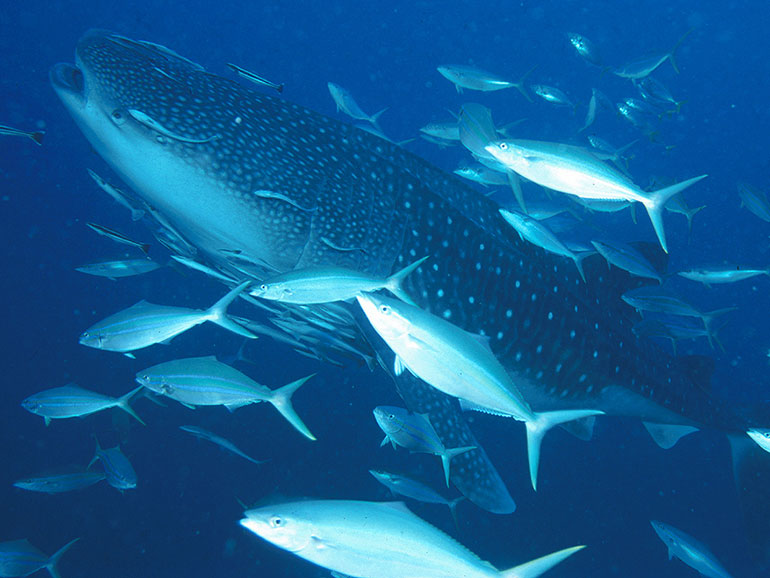
This is a very common question & the easiest answer is in the water! Of course there is an element of luck you have to be in the right place at the right time, however if they are around you will find them within the Tunku Abdul Rahman marine park.
There have been lucky student divers in the past that have been able to see these amazing creatures while taking their PADI Open Water course. Can you imagine seeing one of your first Open water dive? What an experience!
There can be no guarantee of seeing a whale shark as when you are diving in the ocean it is such a vast space. I read somewhere that diving is like going on safari, not like going to the zoo, which is quite realistic. However, the more you dive the better chance you have of seeing this magical creature!
Don’t worry though, if you don’t manage to spot one there are still plenty of amazing things to see such as Eagle rays, school of Barracuda, Snappers, Turtles, Black Tip reef sharks & much much more!
The million-dollar question! Of course nature is quite random but it is typically March- April time in Kota Kinabalu when we gain large plankton blooms which draw in the Whale Sharks in.
Whale sharks have sensory cells in the nasal grooves above the mouth, and these help the whale shark detect food in the water. It has been suggested that whale shark movement patterns are linked with coral spawning and plankton blooms.
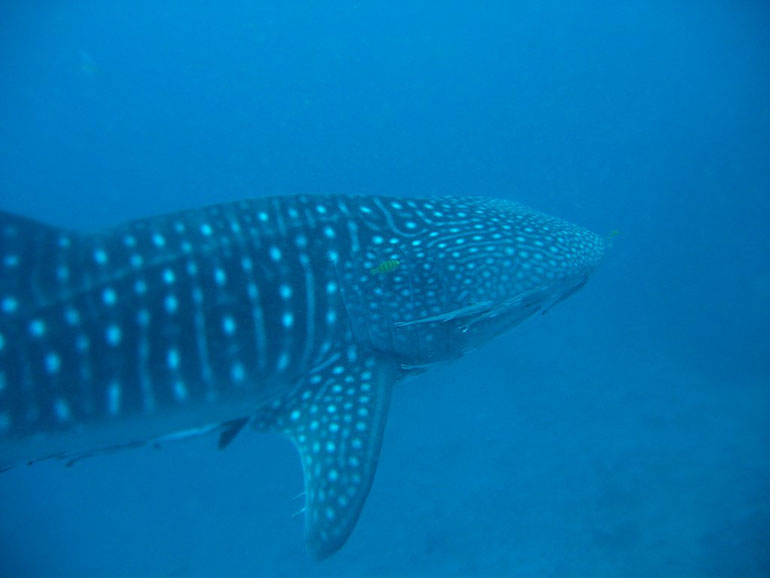
It is important to remember that sharing water with these amazing creatures is a once-in-a-lifetime experience that most people check off their bucket list. However, it is critical that we understand the do’s and don’ts of our behaviour around them, and that we treat these creatures with the utmost respect.
Scuba Junkie adheres to standards & guidelines to ensure we do not endanger, harm or harass the animal. This also means divers can make the most of their whale shark encounter.
We hope you will join us in trying to spot these beautiful animals! Don’t forget nature can change their mind & we can have random visits at other times in the year too! If you are not looking it might just pop up and surprise you!
“From birth, man carries the weight of gravity on his shoulders. He is bolted to earth. But man has only to sink beneath the surface and he is free.”
Jacques Yves Cousteau
Nothing compares to the feeling of taking your first breath underwater. Though the top of your head is just a few centimetres under the surface, you’re immersed in a whole new world. Through your mask you see grains of sand dancing with the waves pushing back and forth, while all the little critters continue going about their day. Curious fish dart around, investigating the newcomer seeking adventure.
You may find yourself one day on the island of Borneo, in Sabah. So much to see and the world is yours. From the capital itself, Kota Kinabalu, you see islands very close-by from the main watering hole at the waterfront in town. With just a short boat ride you could be on one of those islands. As you look out watching one of the best sunsets you’ve ever seen in your life, you wonder, what gems lie on the other side of the islands; on land and the waters below.
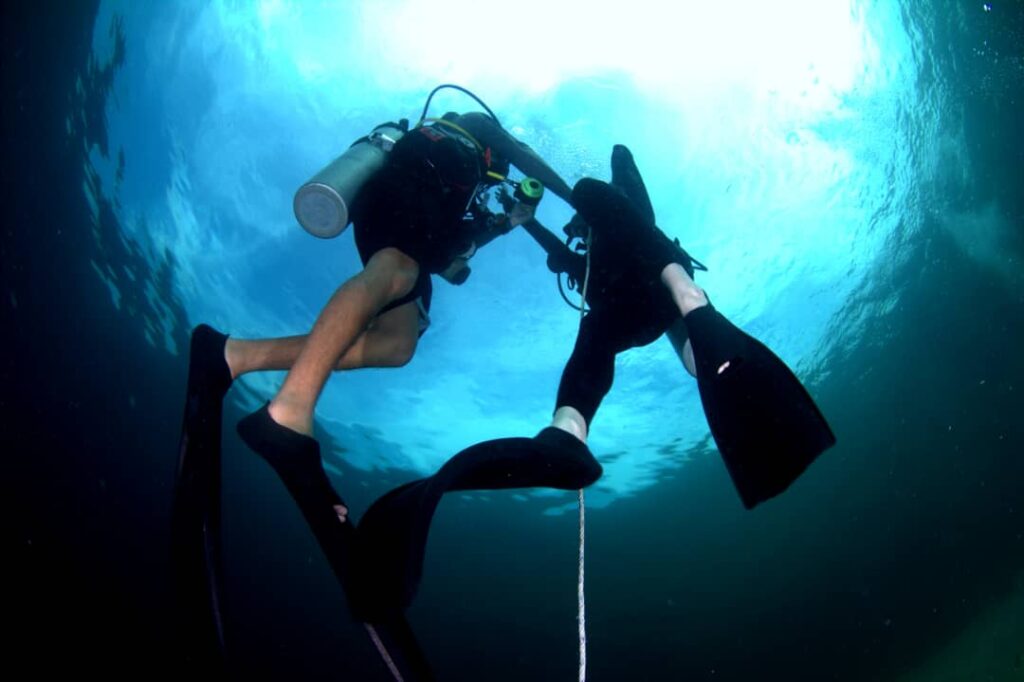
Gaya, Sapi, Manukan, Mamutik and Sulug are the 5 islands that form the Tunku Abdul Rahman Marine Park. Just a 15 minute boat ride from the harbour in the city itself and you get to be on one of the beautiful islands in the marine Park. There’s not many places on earth that have this quality of diving so close to the city.
Waters around the Tunku Abdul Rahman Marine Park are generally calm all year round and currents are usually mild to none which make it ideal for new divers learning new skills and exploring the underwater world.
Since being gazetted in 1974, Sabah Park authorities have been safeguarding the islands and underwater life. Their efforts have helped the marine ecosystem through patrols, educating the public and hefty fines. Because of that, the corals remain vibrant, healthy and full of life.
Southeast Asia is the pinnacle of diving. Just off Kota Kinabalu itself you have the chance to see a wide variety of marine life. From black-tip sharks and schools of barracudas and jackfish, to little critters like neon nudibranchs and peculiar shrimps. Every now and then looking into the blue you might find yourself being eyed by an eagle ray gracefully flapping its wings before majestically darting off with a blink of an eye. Not forgetting of course, those lucky enough to spot the seasonal whale sharks that migrate to Kota Kinabalu waters to feast on krill that spawn between January to March.
Since the islands in Tunku Abdul Rahman Park are between 3-8km from Kota Kinabalu, almost every dive you surface from you get a stunning view of the city and if the skies are clear, you’ll be greeted by the lonely mountain Akinabalu (Mount Kinabalu), a prominent fixture of the skyline.
At Scuba Junkie you’ll be trained by 5 star PADI dive instructors. PADI dive instructors use international standards that give you the proper training and build confidence for diving that lasts a lifetime. Towards the end of your course you will have turned fear into courage, faintheartedness into accomplishment, timidity into confidence and turned anticipation into passion. You’ll be ready and well trained for your next diventure!
Tunku Abdul Rahman Marine Park (TARP) also nick named the KK Marine Park features 5 beautiful islands Gaya, Sapi, Manukan, Mamutik and Sulug. This famous marine park has been a marine park for more then 40 years and its marine life is carefully monitored and protected by Sabah Parks. As a result this area is home to thousands of schooling fish, pristine coral reefs, cool creepy critters such as Frogfish, Octopus, Sea horses, Orangutan crabs and much more! We also have some of the larger marine life such as Turtles, Black Tip Reef Sharks, Eagle rays, Cowtail Rays and even during Spring season the Whale Sharks sometimes come and visit.
All types of divers are welcome here, it is a great place for beginners and also fantastic for experienced divers who want to do a bit of photography. We often have snorkelers too who enjoy the sites of the outer reef rather then the beach seeing much more and get a bit of island time between intervals.There is something here to meet every divers and snorkelers tastes
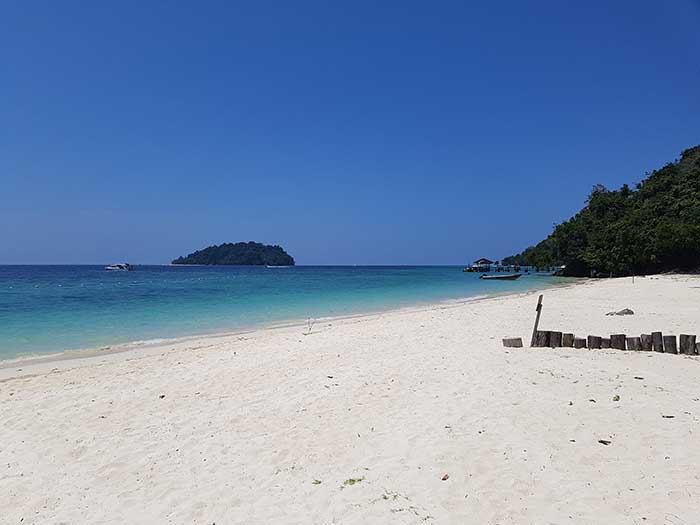
The largest island within the marine park and the closest to Kota Kinabalu. The name Gaya came from a Bajau word “Gayo”which means big. The island is 3,700 acres in size and has an elevation of up to 300 meters. The island is covered in dense tropical forest which is a forest reserve. On the island, there is a 20km long hiking path . There is great wildlife to be seen such as monitor lizards, bearded pigs and the beautiful hornbill birds. One of the popular sites of Gaya island is the legendary beach at Police Bay. There is a long stretch of white sand which slopes out gradually to the sea and make its a perfect spot for swimming and snorkelling in the crystal blue waters. The reefs around Gaya are still in great condition, making it a fantastic spot for diving.
A mixture of shallow macro diving and shallow sloping walls full of coral reefs! Dive sites around this Island range from 5m-30m and offers some amazing macro life such as Frog Fish, Scorpion Fish, Lion Fish, Seahorses, Nudibranchʼs as well as larger marine life such as Turtles, Barracuda, Tuna and even Reef Sharks can be seen.
Sapi means ‘cow’ and the island is said to be shaped like a cow’s head.
Known to be the most beautiful island within the KK marine park. Connected to Gaya via Zip line (a.k.a Flying Fox) which is 235 Meter-long 771 (feet), this is open to thrill seekers who want to fly across the ocean at a vast speed between the two islands, known as the Coral Flyer. This is the world’s longest island to island zip line.
Sapi island is only 25 acres and the second smallest island of TARP. There is not only a wide variety of marine life, but on the island there are also Bearded pigs and monitor lizards.
Sapi offers some amazing white pristine beaches with fantastic reefs for diving. Diving ranges from 8-25m and divers can expect to see Stingrays, Fusiliers, Crocodile Fish, Cuttlefish, Octopus, Moray Eels, lots of nudibranchs, Stone Fish and Anemone Fish plus much more
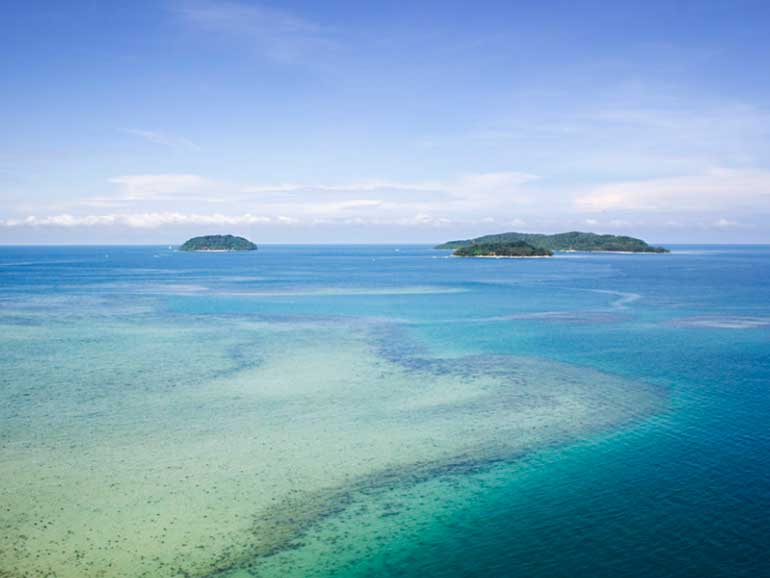
This is the second largest island in TARP quite a popular island for our residents as it has long stretched of beautiful beach for relaxing on and snorkelling around. It is also covered with dense vegetation and has great hiking trails. This Island has very healthy coral reefs teaming with many reef fish and you can even see the very rare and valuable Black Coral diving at this Island. Dive sites vary from 7-25m which makes this island ideal for all levels of divers.
This is the smallest island in the clusters of TARP at about 15 acres in size. However this island goes to show that size is not always everything! A peaceful and mesmerising island with a quiet beach to laze around on. The rich coral reefs are diverse in marine life. Mamutik Island offers divers and snorkelers very healthy coral reefs teaming with a large variety of large and small reef fish. There are also lots of rare macro life such as Frog fish, Lion Fish, Leaf Fish, plus many more. This island is also home to a giant underwater statue of a Seahorse! The Island itself is like an Island post card with pristine white sandy beaches-most of our divers never want to leave
Located on the most southern tip of KK marine park Sulug is the most remote and least visited by tourists. It is around 20 acres. The island has no amenities, thus this island offers nature at its best! A long sand spit extending outwards into the ocean. The diving here is ranked among the best in the marine park with common sightings of sea snakes, turtles, rays, frog fish, morays, lots of nudibranchs, and the coral is pristine with an abundance of marine life-truly a divers haven. We highly recommend you dive here for your 2nd or 3rd day diving within the park.
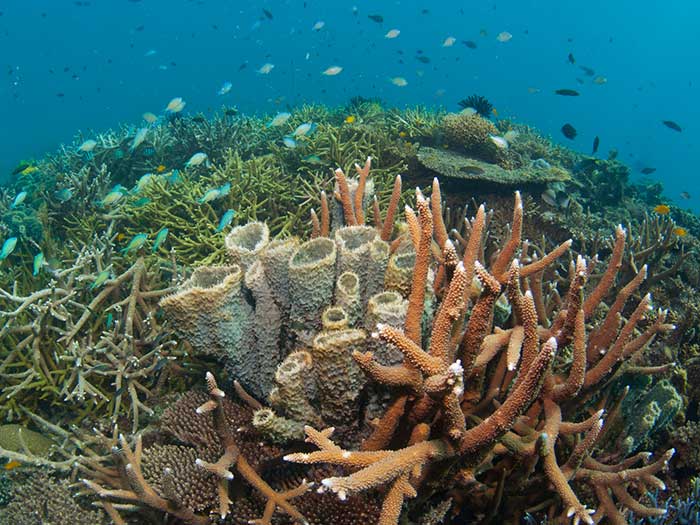
Kota Kinabalu, with its stunning underwater landscapes and rich biodiversity, is a dream destination for divers of all levels. While many are drawn to the big pelagic species or vibrant coral reefs, there’s an entirely different and equally fascinating world beneath the waves: macro diving.
The term macro means large in scale & is a term used in relation to small creatures because photographers use macro lenses to allow them to take big close up images of the minuscule animals.
Macro diving focuses on the tiny, often overlooked creatures that inhabit the reefs. Think of it as underwater photography for the small, from colorful critters like nudibranchs to camouflaged seahorses, and from minuscule shrimp to elusive frogfish. These creatures may be small, but they play vital roles in marine ecosystems, and spotting them requires both keen observation and a patient approach.
The shallow waters, gentle currents, and abundant marine life make it the perfect setting for spotting rare and exotic critters. Whether you’re diving in the crystal-clear waters of the Tunku Abdul Rahman Marine Park or exploring the vibrant underwater gardens of Edgell patches, the possibilities for macro encounters are endless.
Top Macro Diving Spots in Kota Kinabalu with Scuba Junkie
Nudibranchs: These colourful sea slugs are like underwater rainbows. With hundreds of species found in the region, they’re a favourite among divers
Mantis Shrimp: Famous for their powerful claws and vibrant colours, these fascinating creatures can be found hiding in crevices or darting across the reef.
Seahorses: The tiny and delicate seahorse is a rare and magical find, often hiding in seagrass or coral heads.
Ghost Pipefish: These mysterious creatures blend seamlessly with the coral, making them a true challenge to find.
Frogfish: Masters of disguise, frogfish sit motionless, blending perfectly with their surroundings.
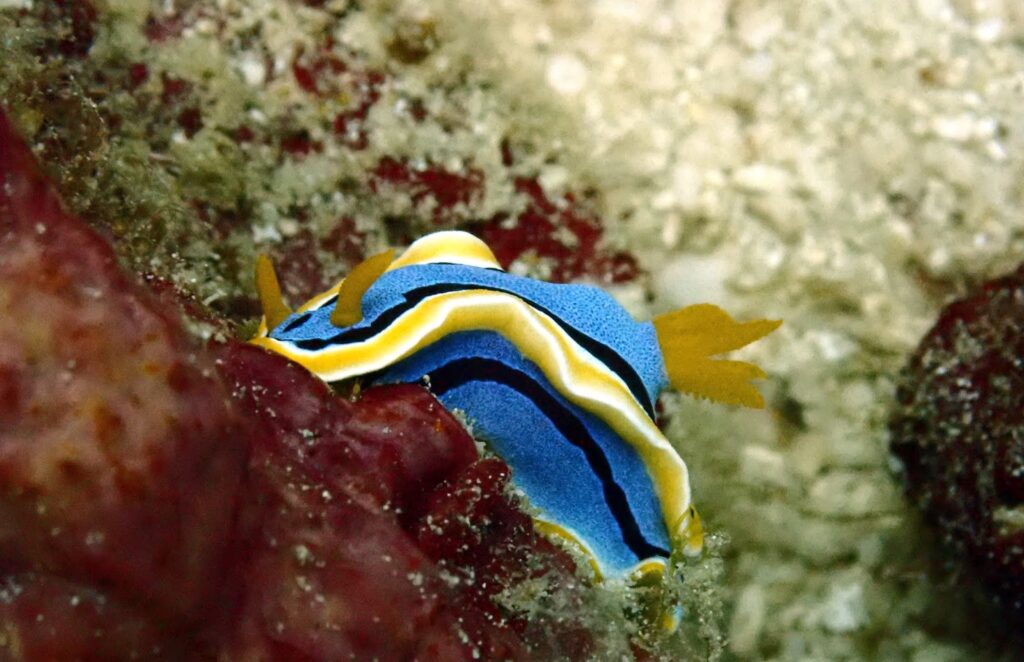
Nudibranchs hold a special appeal due to the large number of different species, colours, patterns and their inability to go anywhere in a hurry!
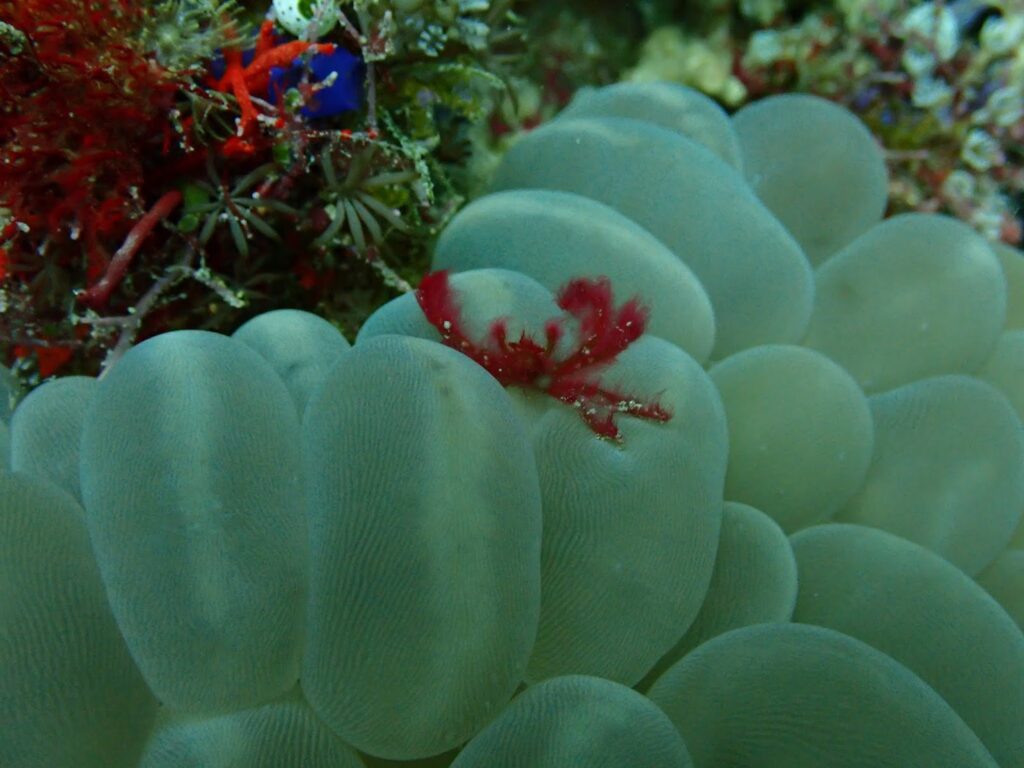
One of my favourites & apt for Borneo, these tiny cute Orangutan crabs are often found on bubble coral, there carapace is so small & has extra long arms compared to its body. It has red/orange fluffy hair, the crab just chills around waiting for plankton to get stuck in its luscious locks & then uses its claws to groom & pick it out for a snack for the day!
When planning your macro diving trip with Scuba Junkie, here are a few tips:
Whether you’re an experienced diver or just starting your underwater adventures, macro diving in Kota Kinabalu is an experience like no other. The diversity of life, the eagle eyed dive guides, and the stunning dive sites all combine to create an unforgettable adventure. With Scuba Junkie’s expertise and passion for the ocean, you’ll be sure to leave with a deeper appreciation for the delicate beauty of the marine world and a camera full of incredible memories.